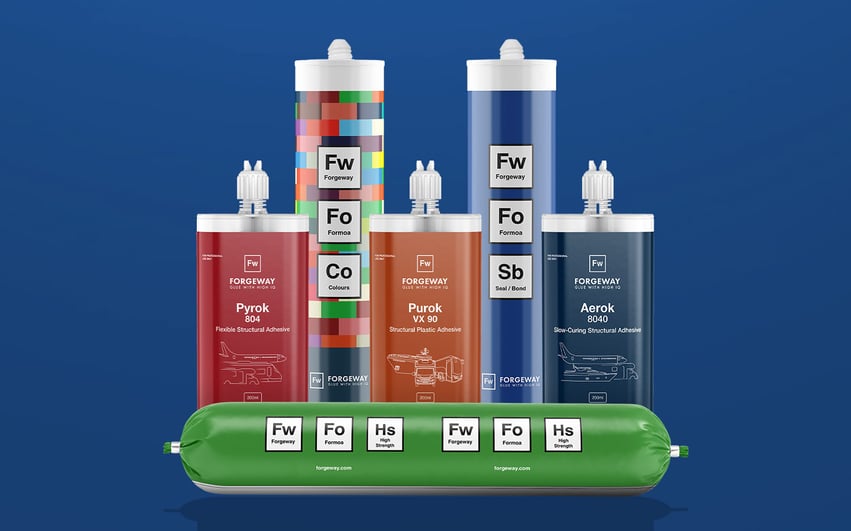5 ways you can maintain the right temperature when storing adhesives

When it comes to storing adhesives, you will know that maintaining the temperature is the most important thing when maintaining the performance of the adhesive. Nonetheless, you’re a bit stuck. You are unsure about the best way you can maintain the correct temperature of the adhesive in storage.
As adhesive manufacturers here at Forgeway, we have a few tips and tricks for you. We manufacture industrial adhesives and have learnt a thing or two over the years about adhesive storage.
We like to share what we know. So, we wrote this article to give you five ways you can maintain the right temperature when storing adhesives. By the end of the article, you will know how to preserve the performance of your adhesives.
Why maintaining the correct temperature of storage is important for adhesives
The main reason you should maintain the correct temperature is to preserve performance. All adhesives will have guidance for their ideal temperature. However, you will experience the least amount of issues if you keep the storage temperature between 15℃ and 25℃. But why will it affect performance if you stray from these guidelines?
We wrote a separate article that goes into the reason why it can affect performance. The short and sweet answer is that prolonged periods of too-low (below 0℃) or too-high (above 35℃) temperatures will permanently damage the adhesive.
Not all adhesives are the same. Some adhesives can withstand temperatures up to 50℃. Other adhesives cannot withstand temperatures above 25℃. It all depends on the specific requirements for your adhesive choice.
Short periods of too low or too high temperatures will result in temporary performance defects. The defects will depend on whether the adhesive is one-component or two-component.

One-component adhesives (especially MS polymers) will become a lot more viscous when stored below 10℃ for a short period. Therefore, they become difficult to gun out and work with.
When stored in temperatures above 25℃, the opposite is true. The adhesive will become significantly less viscous. Whether it becomes more or less viscous, you will face the same problem. The existing application equipment might not work with this different viscosity. You will also find that MS polymer adhesives will have less grab when they get too warm.
Two-component adhesives (like MMAs or epoxies) will cure a lot slower and may mix unevenly when stored in too-high temperatures. Uneven mixing will affect the performance of the adhesive. Some epoxy adhesives will not cure at all if the temperature is too low. And you need to store some methyl methacrylate adhesives in a fridge to maintain temperature.
Ultimately, you will find that storing any adhesive at incorrect temperatures will affect the performance. It may even cause the adhesive to be unusable. You just need to find out the correct temperature and make sure you store the adhesive within that temperature.

The 5 ways you can maintain the temperature of adhesive storage
So now you know that storing the adhesive at the correct temperature is going to affect the performance. It’s time to ensure the storage is going to maintain the correct temperature. This section will give you tips on how to maintain the correct temperature.
1. Ensure the storage unit has heating or air conditioning
This is the easiest way to adjust the temperature of the storage. If it is getting too hot or cold, you can turn the air conditioning/heating on. This will ensure the temperature stays within the range it is supposed to.
The feasibility of this option depends on how much adhesive product you store. You can purchase air-conditioned storage cabinets that will stay within the correct temperature range for the adhesive. However, if you have large quantities of adhesives, this option is going to be very costly.

2. Keep doors and shutters closed
If you are planning to store your adhesive in a large warehouse, you will want to make sure the doors and shutters are kept shut. This will ensure the outside air (whether hot or cold) is kept out of the storage unit. Ultimately, it will help you keep control over the temperature of the storage.
3. Keep the adhesive raised off the floor
This, once again, applies to storage in large warehouses. This is because warehouses have hard flooring (like concrete). The hard floor doesn’t heat up very easily. So if you are storing the adhesive on the floor, the cold will transfer to the adhesive affecting its performance.
Even raising the adhesive to the height of a pallet can make a huge difference. So, we always advise keeping the adhesive raised off the floor.

4. Don’t forget about the night-time temperature
Keeping the shutters and doors shut during the day is just one-half of the effort. You need to make sure the temperature doesn’t severely drop during the night.
We often see this becoming an issue during early-Spring/late-Autumn. Companies turn off overnight heating because the days are warm, but they forget that the nights are significantly colder. The drop in temperature overnight affects the adhesive’s performance.
5. Use foil-pack/cartridge warmers
It doesn’t matter whether you are using foil-pack systems or cartridges, you can purchase sleeves or boxes that go around the packaging to keep them at the right temperature. These are primarily for one-component systems.
They are very effective. But if you are storing large quantities of adhesives, it isn’t very practical as you can only store up to two products in the warmer at the same time.

Why maintaining temperature is only one part of preserving performance
Now you know why temperature is so important for adhesive storage, you will want to try and implement this into your organisation. However, there are several other things you can do to maximise your adhesive’s performance.
Here at Forgeway, we manufacture industrial adhesives. Over the years we have seen countless occasions where poor adhesive storage has a significant impact on adhesives’ performance.
So we wrote an article that goes over the dos and don’ts of adhesive storage. We wanted to share what we know about adhesive storage. You should read that article to gain an understanding of what you need to remember when storing adhesives. Click on the banner below to read that article.
However, you may not know the best route forward for your adhesive storage. You can reach out to an adhesive expert to advise you on the next steps for optimising the performance of your adhesives.
Thomas is the Content Manager here at Forgeway. Thomas' job is to translate the technical jargon from the ivory tower of academia into easy-to-read content that everyone can understand. Forgeway's mission is to answer every question our customers and prospective clients ask, or are apprehensive to ask.
Topics:



